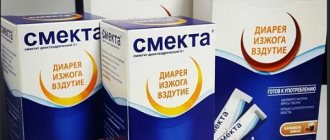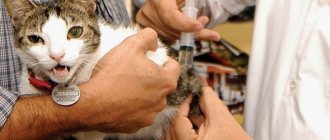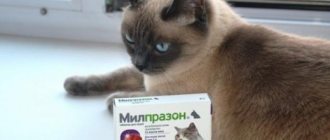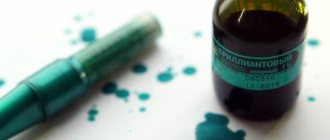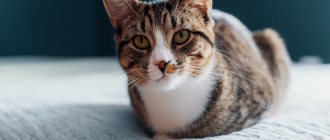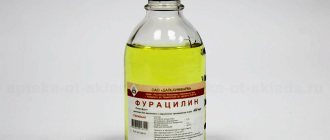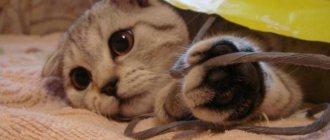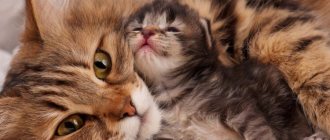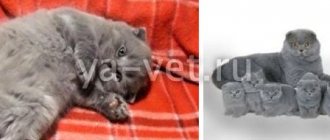It's no secret that a newly born kitten needs full care and attention. In particular, issues related to nutrition require due attention from the owners, because the furry baby’s digestive system continues to develop. Often, because an animal is prone to frequent intestinal disorders, it is necessary to seek help from specialists. In turn, doctors most often prescribe Smecta to cats at any age.
Composition and action
The active substance of Smecta is diosmectite. This is a natural component, a mixed oxide of silicon and aluminum (or magnesium and aluminum silicate). Sodium saccharinate and dextrose promote better absorption of the medicine. The powder may have a citrus or vanilla flavor, but for animals it is better to choose a medicine without flavoring.
The general effect of diosmectite in both humans and animals is the adsorption of pathogenic microorganisms located in the gastrointestinal tract. It has the ability to bind toxins and infection-causing pathogenic microflora in the animal’s body. The mucous barrier is stabilized, the amount of mucus increases and its gastroprotective properties improve.
An important therapeutic effect of the drug is to protect the mucous membranes of the digestive tract from the negative effects of hydrochloric acid, bile, bacteria and their toxins, and various other aggressive factors. An additional protective layer of the mucous membranes of the gastrointestinal tract eliminates irritation and prevents further intoxication of the body.
Important!
The drug is absolutely safe for animals, however, it reduces the rate of absorption of other medications, so it is not recommended to give Smecta to a cat simultaneously with other medications.
The procedure for introducing the drug into the cat's mouth
To help a cat cope with the disease, the breeder will need 1 sachet of Smecta, boiled and cooled water in advance, a clean towel and a syringe without a needle. Despite the malaise, not every animal completes the course of treatment prescribed by the veterinarian or the breeder himself with great pleasure. To give Smecta to a cat, the owner will have to show miracles of ingenuity and simple admonitions; kind words will not help here. It is much easier to adhere to certain rules .
- Place the contents of the sachet into the prepared container. For an adult cat, 1.5 grams of Smecta is enough. The powder should be diluted to a pasty consistency. This will require 50-100 ml of water.
- To inject the prepared suspension into the cat's mouth, a regular 2-cc syringe is suitable. It must be filled in advance so as not to irritate the sick animal.
- Immediately before administering Smecta, you should wrap your beloved pet in a thick cloth or towel. In this case, it is necessary to fix his legs and body, but do not overdo it. Do not forget that the unfortunate mug is most likely suffering at the moment from severe pain in the tummy.
- The syringe is inserted into the cat's mouth from the side where the teeth are missing. You don't have to make any special efforts. There is no point in carefully opening the mouths of Murka or Barsik. It is enough to lift the upper lip by 1-2 mm and gradually squeeze out the contents of the syringe.
© shutterstock
How many times a day to give a cat Smecta depends solely on the condition of the animal. For the most severe disorders, veterinarians recommend repeating the procedure for administering the drug every hour. Particular attention should be paid when treating kittens. If after 6-8 hours the furry little one’s condition does not improve, you should immediately seek help from a qualified veterinary clinic specialist. In such cases, there is always a risk of having diseases not only of the gastrointestinal tract.
Purpose
Smecta is used as veterinary first aid for the first symptoms of gastrointestinal diseases, accompanied by vomiting and diarrhea. The drug is used as an enterosorbent for digestive disorders associated with poisoning from poor-quality food or a change in feed. The drug is safe for pets, including kittens.
The indication for prescribing Smecta as a medicine is diarrhea of various etiologies:
- with individual intolerance to certain foods;
- an excess of proteins in the diet (diarrhea is often accompanied by itchy skin and hair loss);
- transferring an animal from natural food to industrial feed and vice versa;
- transferring kittens after weaning from a cat to adult food;
- long-term treatment with antibiotics;
- infectious diseases.
Smecta will help against vomiting that accompanies infectious diseases or is caused by overeating (often in kittens that do not feel full), or the accumulation of hairballs in the gastrointestinal tract.
Important!
When vomiting, the composition of the vomit should be taken into account. If there is blood in them, you should immediately show your pet to a veterinarian, since this symptom indicates internal bleeding.
Causes of diarrhea in cats
Almost every owner has had to deal with intestinal upset in pets. Even a seemingly insignificant event such as moving to a new apartment can cause stress in cats, causing diarrhea. In small kittens, intestinal upset can be caused by overeating. After transferring a kitten to “adult” food, its body needs to readjust: to digest wet and dry food, different enzymes are needed than to digest mother’s milk. In addition, kittens do not feel full - they will eat until there is no food in the bowl.
Much more serious problems are caused by dangerous pathologies:
- poisoning;
- viral infections;
- imbalance of intestinal microflora - including after antibiotic therapy;
- helminthic infestations.
The biggest danger with prolonged diarrhea is the risk of dehydration. A large amount of fluid is washed out of the body with feces. A life-threatening condition occurs if the body loses 15-20% of water. Dehydration can cause the kidneys to fail, and then the pet will die. Therefore, it is important to consult a veterinarian for intestinal disorders and not self-medicate.
Important!
Prolonged diarrhea (more than 3 days) leads to weight loss, dehydration, loss of protein, and impaired tissue trophism. The result may be chronic renal failure, hypothermia, convulsions, and cerebral hypoxia.
Diarrhea may be accompanied by vomiting, and these are not always signs of poisoning. More often this is a systemic disorder, the causes of which can be different - from intestinal obstruction to oncology.
If you have diarrhea, you should pay attention to the color of the stool: it can indicate in which organ the pathology is developing:
- Unformed yellow stool may indicate diseases of the liver parenchyma. You should contact your veterinarian immediately;
- Green diarrhea can be observed due to putrefactive processes in the intestines, poisoning with low-quality feed, stale food;
- White feces are the most dangerous symptom of bile duct blockage and require immediate contact with a veterinarian.
Mucus in the stool is a sign of intestinal inflammation, an imbalance of beneficial and harmful bacteria in the gastrointestinal tract. It can be a sign of a deadly disease - viral peritonitis, and therefore requires complex treatment, and Smecta is used as a means of symptomatic therapy - to improve the condition of the animal.
Important!
Other dangerous viral diseases accompanied by diarrhea include enteritis and panleukopenia (feline distemper).
Diarrhea with blood is a reason to immediately contact a veterinary clinic. It may be a symptom:
- poisoning with pesticides, household chemicals;
- rectal trauma, intestinal rupture;
- acute pancreatitis;
- helminthic infestations (infection with coccidia, Giardia);
- viral diseases, in particular coronavirus, panleukopenia;
- oncology.
Why does kittens get upset?
Often, with the beginning of dramatic changes in a pet’s diet, that is, when switching from mother’s milk to artificial food, digestive problems may occur. Veterinarians say that it is undesirable to introduce a baby to adult food before one month of age. You can avoid problems with the stomach and intestines if you give slightly moistened food, which will facilitate the rapid adaptation of the digestive system after liquid milk.
Meanwhile, few people know how to properly give the drug to a pet. The method of application, dosage and other important points concern the owners, since, first of all, “Smecta” is intended to relieve people from diarrhea. It turns out that if there is an intestinal disorder, this medicine is also indispensable for animals. After reading the instructions for use of the drug, you can easily figure out how best to give Smecta to a cat.
Dosage
You can buy Smecta at any pharmacy. 1 sachet contains 3 g of powder for preparing a suspension. The dosage will depend on the age and weight of the pet. Kittens can be given enterosorbent from 1 month. To prepare the suspension, you need to take 0.5 sachet and 50 ml of water (for adult cats) or ¼ of the contents of a sachet and the same amount of water (for kittens). The solution must be mixed thoroughly until the powder is completely dissolved, then drawn into a syringe. It is more convenient to use small, 2-5 cc syringes.
You need to infuse the medicine after securing your pet with a towel or diaper. This way you can protect yourself from the cat’s sharp claws. For kittens, the volume of the finished medicine for one dose is 2 ml, for adults – 5 ml. You need to pour the solution into the mouth carefully, from the side, then lightly pinch the muzzle and mouth so that the cat cannot spit out the medicine. After 1-3 hours, the procedure should be repeated.
Important!
Taking Smecta does not relieve the owner of the need to take the cat to the veterinarian to determine the cause of the intestinal disorder.
What does the owner need to know when treating a cat with Smecta?
The result of the treatment will not take long to arrive: literally in 2-3 hours the pet will feel much better. During the procedure for administering the drug to an animal, the owner needs to make sure that the kitten has swallowed the drug. If an attempt to administer the prepared emulsion is unsuccessful, you should start treatment again. It is possible that outside help may be needed to achieve the goal.
If there is no improvement, the procedure must be performed again after 3-4 hours. It is equally important to provide the cat with sufficient fluid intake to avoid dehydration. At the same time, you can wait until the functioning of the digestive organs is completely restored. In the absence of positive dynamics in the treatment of the animal, it is advisable not to neglect the advice of specialists. By contacting a veterinarian, who will give additional recommendations for treatment or prescribe another medicine, the owner will help rid his pet of diarrhea much faster.
Restrictions
The drug has no contraindications. Smecta can be used to treat kittens from one month of age, pregnant and lactating cats. However, if the cat has a tendency to constipation, it is not recommended to give the suspension even with loose stools. The prohibition for taking is intestinal obstruction.
Important!
If, after taking Smecta, the cat has difficulty defecating (constipation), the medicine should be discontinued or, after consultation with a veterinarian, the dosage should be changed.
Reception by children
Smecta can be given to children from infancy. Often, babies have problems with the digestive system in the first days of life.
The instructions say that you can give the medicine from 4 weeks. The remedy can be given for malnutrition, which leads to abdominal pain and bloating, vomiting and diarrhea. Also effective for jaundice.
The optimal dose is determined only by a doctor. You need to dilute the powder in warm milk or water (50 ml), stirring until you get a homogeneous consistency. The specified volume must be divided into several doses.
For diarrhea
If a baby has diarrhea at the age of 1-12 months, then in the first 72 hours you need to give 2 sachets, after which you can give 1 sachet per day. Children from 1 year old can be given 4 sachets in the first 3 days, and after that - 2 sachets per day.
When vomiting
For vomiting in children under 1 year of age, give 1 sachet per day. A child over one year old can be given 3 sachets per day. If constipation occurs, the dose should be reduced.
How to administer the solution to a cat
The animal, of course, is unaware of the benefits of Smecta. Therefore, he will not drink it voluntarily. It is useless to mix with food. The body gets rid of powder and food faster than necessary.
It is better to carry out the treatment process with someone in pairs. One holds the patient tightly (you can wrap him in a sheet, towel, scarf, etc.), the other tries to inject the dose. Just don't squeeze the cat. Her stomach hurts too much. The syringe is inserted into the mouth, under the root of the tongue on the side. In this position, the patient will not be able to spit out the medicine.
If the cat wants to drink after this, do not interfere. There will definitely be no harm from water.
After the procedure, we observe the animal. If everything is in order, then after 2 hours we repeat again. A lasting improvement should occur in about 8-9 hours.
What is diarrhea in cats
Diarrhea (diarrhea) is not an independent disease; the condition is a signal of the presence of certain health problems in the cat. We are talking about dysfunction of the digestive tract, which is accompanied by excessive loss of fluid, pain in the abdomen, nausea, vomiting, weakness and loss of appetite. In cats, frequent loose stools are caused by increased intestinal motility, provoked by irritation of the intestinal mucosa by pathogenic bacteria or toxins.
Along with frequent defecation, the animal behaves restlessly, experiences discomfort, and often cannot find a place for itself. Despite the fact that in the vast majority of cases, a disorder of the digestive system does not pose a threat to the cat’s life, it is important to understand that prolonged diarrhea can lead to dehydration and can cause the death of the pet. It is extremely important to correctly recognize the symptoms of the disorder and promptly help the animal on your own at home or in a hospital.
Should I give Smecta to a kitten?
Due to its pronounced adsorbing properties, high fluidity and excellent enveloping ability, once in the digestive tract, Smecta has the following effect on the human or animal body:
Smecta, when used according to the instructions, does not affect intestinal motility, is not absorbed by the body and is excreted unchanged.
Contraindications:
- Hypersensitivity to the drug components.
- Intestinal obstruction.
- Constipation.
To prepare the drug you should:
Pour the contents of the sachet (3 g in 1 sachet) into a cup or bowl. Gradually add 100 ml of warm boiled water, stirring the mixture. The resulting suspension should have the consistency of liquid sour cream. Draw the drug into a syringe without a needle. Raise the cat's head. Carefully inject the medicine into the pet's cheek from the corner of the mouth; Make sure your cat doesn't choke.
If the cat resists, it needs to be swaddled, which will make it more pliable. The swaddling should be quite tight so that the animal cannot free itself, but can breathe freely. To do this you need:
- Lay a towel approximately 1 m long and 0.5 m wide on the bed horizontally
- Place the pet on its side in the middle and across the towel so that its head is beyond the edge of the towel
- Wrap the animal, starting from the limbs, holding the front paws first, then the whole cat
After swaddling, the pet must be held firmly, although not too tightly; this will further reduce its resistance.
Before giving an effective dose, you need to make sure that this drug is not contraindicated for the cat. To do this, give the animal one drop of the prepared drug. If no reaction is observed within 10 to 15 minutes, then an effective dose can be given.
Cats have a very sensitive digestive system. A malfunction such as diarrhea can have various causes: allergies, stress, consumption of not entirely natural products (including milk), overeating. Very often, diarrhea develops if the cat’s diet changes dramatically, for example, from natural to industrial.
If your pet has diarrhea due to poor nutrition or eating low-quality foods, you should and can give Smecta without a veterinarian's prescription. If you are sure of the cause of the disease, there is practically no risk. There is also the other side of the coin - treating the symptom, that is, when diarrhea is only part of the picture.
Simply put, Smecta is a good drug, but not magical. In addition, if your pet has a more serious illness, treating diarrhea may distort the history, which will complicate further diagnosis.
Smecta is a powder of a pleasant, creamy color with a sweetish odor and a uniform structure. The drug is packaged in sachets for single use. Once opened, the powder can be stored for no more than a day, since it absorbs moisture from the air and partially loses its medicinal properties. Since the drug is intended for humans, a dosage of 3 grams is incorrect for a kitten. To take Smecta, you need to dilute it in 100 ml of liquid and mix thoroughly. For a kitten, the suspension is given from a syringe without a needle, 0.5–1 cube.
Special conditions and contraindications
Since Smecta has an enveloping effect and absorbing abilities, it can influence the speed and degree of adsorption of other drugs. The highest thickness of mucus is formed within 30 minutes after taking the drug, then it gradually decreases. Therefore, it is advisable to give any other medications to the animal at least 1 hour before taking Smecta. Otherwise, the product will bind to the sorbent and leave the body without having time to act.
You should not give Smecta to a cat if you suspect intestinal obstruction.
Analogs
Enterosorbents are of several types based on their chemical structure (carbon, based on natural, synthetic resins, dietary fiber, silicon-containing). Smecta is a natural silicon-containing sorbent.
Analogues from the natural group:
- Polysorb;
- Kaolin (white clay);
- Neosmectin.
Synthetic analogues:
- Enterosgel;
- Enterodesis;
- Enterosorb.
Studies have shown that the power of Smecta as a sorbent is higher than that of Polysorb and Enterosgel. Smectite, due to its enveloping ability and fluidity, covers a significant surface of the intestinal mucosa.
The advantage of Smecta among other sorbents is also its complex action. The main component of the product absorbs gases, undigested carbohydrates, bile acids, bacteria, rotaviruses.
